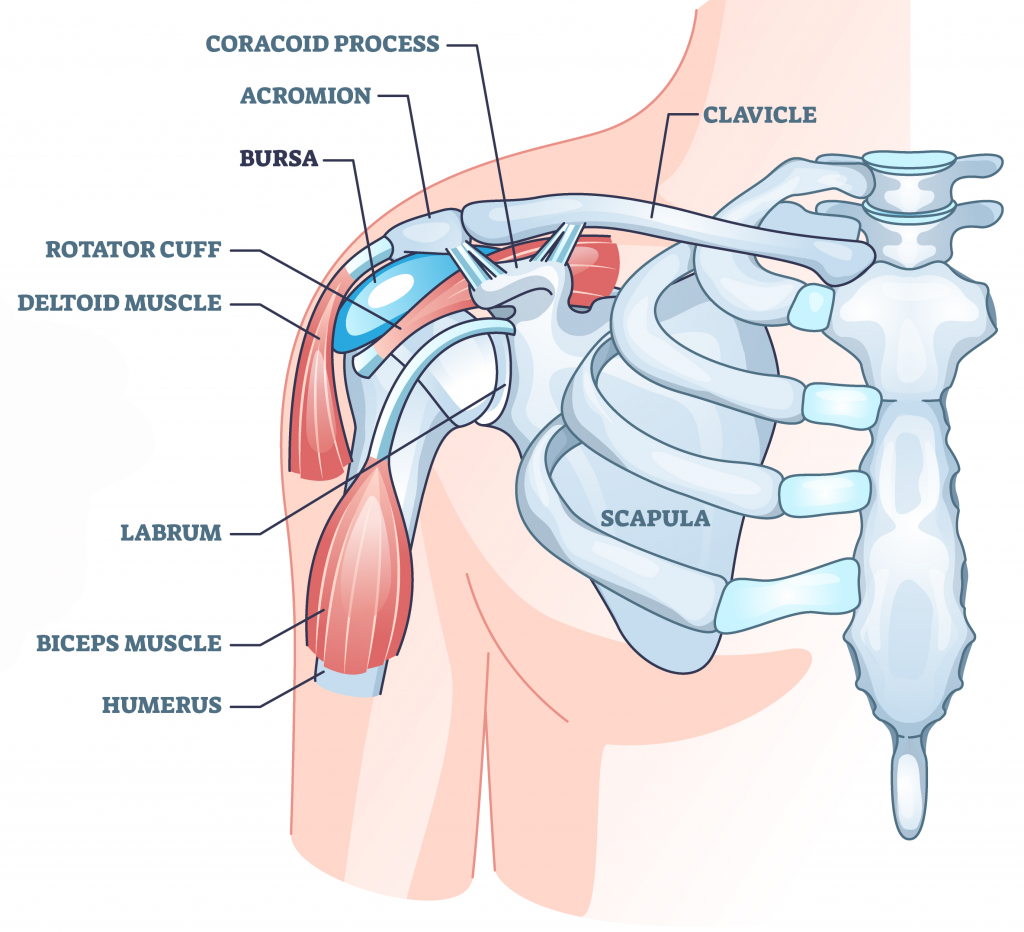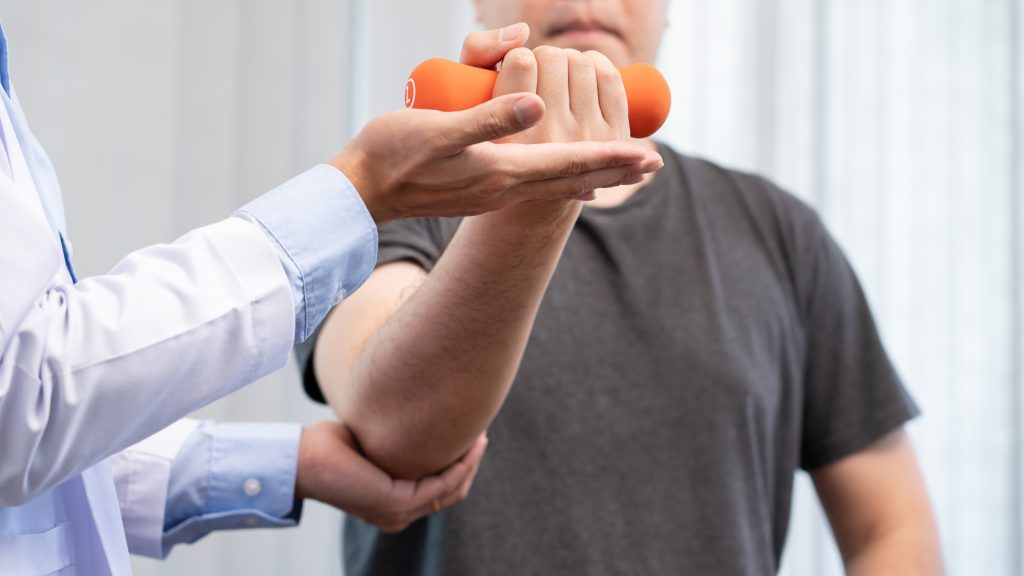
The labrum of the shoulder can be an area of the body that is vulnerable to injury. Activities ranging from repetitive motions like lifting, holding objects overhead, to sports-related activities with throwing from the shoulder and blows to the shoulder, can each cause the dreaded shoulder labrum tear or rotator cuff trauma that sometimes needs surgery to repair. A torn labrum is sometimes difficult to diagnose because of the many shoulder ligaments and muscles in the area. Symptoms like shoulder pain, a feeling of shoulder popping, rubbing or catching, experiencing difficulty lifting a shoulder or arm, or a sensation that the shoulder is coming out of its ball-and-socket joint are signs of a torn labrum. Because the shoulder ball is much larger than the shoulder socket, shoulders are unstable joints, prone to dysfunction when overused or traumatized. If surgery is required to repair an injury, physical therapy may be prescribed and helps patients safely recover shoulder mobility, improving strength and stability, reducing pain, and ideally providing a return to normal shoulder use and range of motion. The physical therapist will make an assessment, hear the patient’s goals and create a treatment plan and timeline of care. Postsurgical PT rehabilitation typically progresses through four phases:

¥ Phase I: For maximum protection when the arm is typically in a sling, where the physical therapist helps with strategies of everyday tasks like bathing and dressing and teaches gentle isometric strengthening and range-of-motion exercises, as well as hands-on treatment including gentle massage, cold compression and electrical stimulation to address pain.
¥ Phase 2: For moderate protection to begin restoring shoulder mobility when sling use is diminished and where exercises become more challenging to carefully work for strength and support, but not too aggressively, and avoiding heavy lifting and repetitive use, but working the shoulder’s range of motion.
¥ Phase III: For returning to normal activity to restore full strength and use, advancing the difficulty of appropriately challenging but safe exercises and movements, and avoiding strenuous activity.
¥ Phase IV: For returning to work and sports and other activities of higher levels with appropriate practice and drills for everyday tasks, along with instructions for proper positioning for the activities to help prevent reinjury.
Physical therapy is considered a significant portion of shoulder surgery recovery, especially because a repaired labrum or rotator cuff is susceptible to reinjury. Regaining restored movement and full use of an injured shoulder helps reduce the vulnerability of re-injury.
Balance and Strength Exercises for Tennis Players
EACH EXERCISE SHOULD BE DONE FOR 30 SECONDS, TWO TO THREE TIMES.
WITH MOST SPORTS SPEED, AGILITY, ENDURANCE, BALANCE AND MORE GOES INTO BEING AN ELITE ATHLETE. TENNIS REQUIRES QUICK CHANGES IN DIRECTION WITH THE ABILITY TO CREATE POWER AND STABILITY. THESE FIVE EXERCISES CAN IMPROVE ATHLETICISM AS WELL AS PREVENT COMMON INJURIES THAT MAY OCCUR WITH CHANGE IN DIRECTION.
Lateral Two-Foot Hop
Keeping both feet together while standing on the side of a line, start by hopping over the line laterally as quick as you can, then jumping back. The goal is to get over the line quickly, not how high you can jump over the line.
Back and Forth Hop
With both feet together, stand behind the line facing forward. Once the timer begins, jump forward over the line with both feet together, then backwards as quickly as possible.
Single-Foot Hops
This exercise is done in the same fashion as the above variations with the exception of only using one foot at a time when hopping over the line. Begin with hopping side to side for one set, then switch to the other foot.
Second variation, hop on one foot forward and backward as fast as you can, alternating which foot you are hopping on after the allotted time.
Skaters
This exercise is used to increase ankle stability and endurance and targets the glutes, leg power and most importantly hips. Skaters are also great for the side-to-side change in direction used in tennis. Start by standing on your left foot. When the timer starts, jump off your left foot in a lateral motion to land on your right foot. Repeat with your right foot, jumping side to side in a skating motion until the timer stops.
Curtsy Lunge
This exercise helps to form core stability, improve leg strength and increase lateral power. Start with your legs side by side. Step your right foot backward and across behind your left foot while keeping your hips stable and facing forward. Gradually lower into a lunge by bending both legs into a 90-degree angle. Come back into the starting position and perform on the other leg. Continue for 10 alternating repetitions on each leg.
How A Physical Therapist Can Help with Tennis Elbow

Tennis elbow is an aggravated injury that can occur from various activities. Lateral Epicondylitis is a painful condition that occurs when tendons in your elbow are overloaded, usually by the repetitive wrist and arm motions. This condition does not only trouble those who are athletes but anyone who tends to overuse these tendons. Symptoms to look for are pain that travels from the outside of your elbow into your forearm and wrist. You may also experience discomfort or pain when turning a doorknob, gripping objects, or drinking a simple cup of coffee. The elbow tends to have a burning or stabbing pain and occasional stiffness. To get an accurate diagnosis, take a visit to your physician, where they can diagnose and prescribe physical therapy. There are several ways to heal and rehabilitate the injury, one being with the professional guidance of a physical therapist who can heal you up expeditiously. Physical therapy for tennis elbow is usually designed for frequent sessions targeting the joint’s repair, strengthening and mobility. Adam Sideline, MD from denvershoulderesurgeons.com, states that “Following a well-structured conditioning program will help you return to daily activities and sports and other recreational pastimes.” A physical therapist will recommend a variety of modalities while educating to allow the patient to continue the program even after their physical therapy is completed. They can help you learn the proper technique in the activity that caused the injury. Webmd.com states that physical therapy can also help improve blood flow to the tendons, which don’t get the same blood and oxygen supply as muscles typically receive. Exercises that will enhance blood flow will improve healing, too.
There may be a variety of treatments used in the process, from hands-on therapy to ice and heat treatments. A variety of exercises such as wrist stretches, extension eccentrics, palm slides and towel twists may be used to help regain entire movement. It is essential to have a physical therapist determine what is suitable for your particular diagnosis. They will also assist you with the correct way of performing each exercise and stretch to ensure you are not further aggravating the injury. Most often, people will leave the injury to heal on their own, but this is less effective since they may experience recurring pain more often than not. A physical therapist will help heal and teach to prevent any aggravation or recurring injuries to the same tendons.
